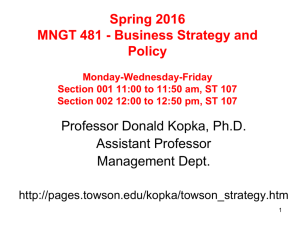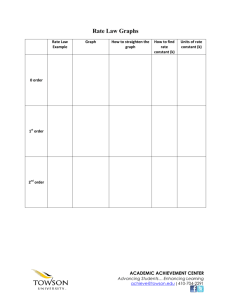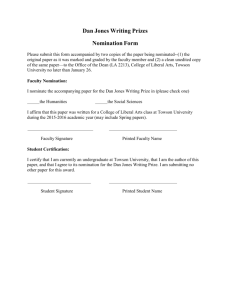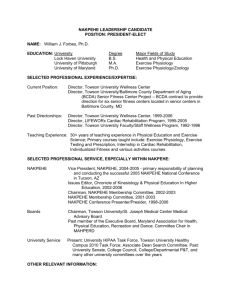File - Gregory Greben Jr. Portfolio
advertisement
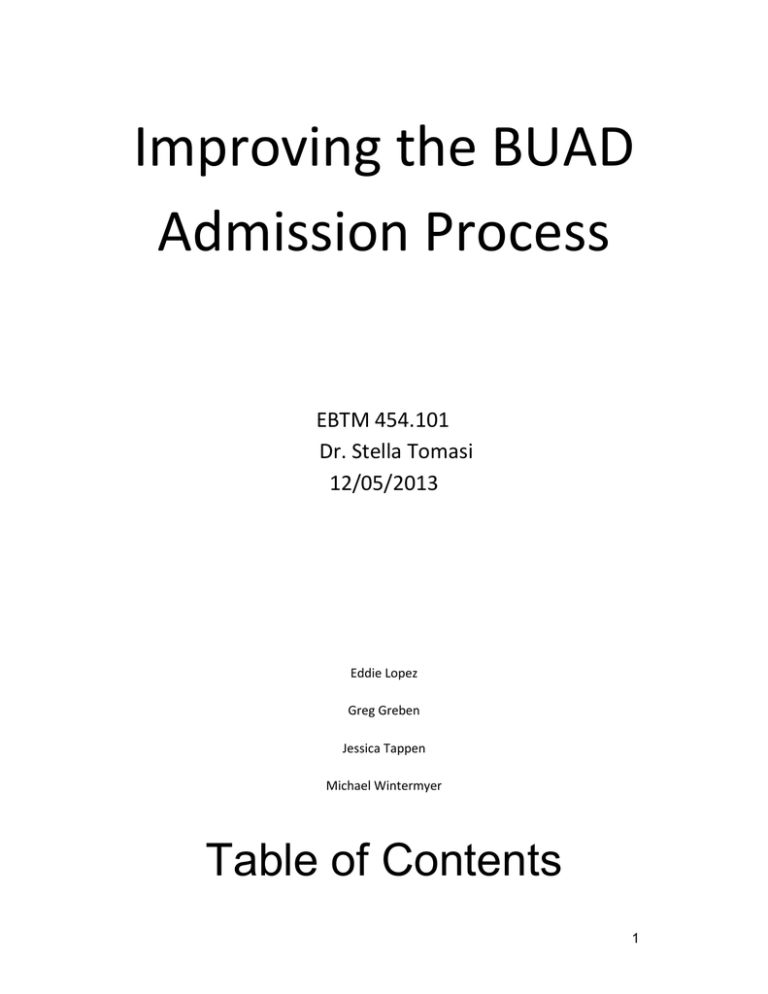
Improving the BUAD Admission Process EBTM 454.101 Dr. Stella Tomasi 12/05/2013 Eddie Lopez Greg Greben Jessica Tappen Michael Wintermyer Table of Contents 1 Executive Summary………………………………………………………………………………………….Pg. Mission Statement…………………………………………………………………………………………...Pg. Vision Statement………………………………………………………………………………………….…..Pg. Requirements for BUAD Admission…………...…………………………………………………....Pg. BUAD Admission Process………………………………………………………………………………….Pg. How the process fits in the Organization…………………………………………………….…….Pg. Roles…………………………………………………………………………………………………………….….Pg. As-Is Process Model……………………………………………………………………………………..…..Pg. Issues with As-Is……………………………………………………………..………………………………..Pg. Recommendations……………………………………………………………………………………….…..Pg. To-Be Process Model………...…………………………………………………………………….……...Pg. Conclusion………………………………………………………………………………………………………..Pg. Appendices……………………………………………………………………………………………………...Pg. Figure 1: PBUA Admission Form……………………………………………………………..Pg. Figure 2: As-Is Admission Model……………………………………………………………..Pg. Figure 3: To-Be Admission Model…………………………………………………………...Pg. References………………………………………………………………………………………………………..Pg. Executive Summary Tiger Consulting LLC (TC) is Towson University’s process management team responsible for improving processes throughout the university and businesses surrounding the Baltimore area. TC is part of Towson University’s Division of Innovation & Applied Research (DIAR). A goal of 2 DIAR is to build strong links between Towson University and the Baltimore community it serves. Located within Towson University, TC consultants apply diverse strengths, knowledge, experience, skills, and unique approaches to problem solving, in order to develop customized recommendations focused on solving critical issues within processes. TC can cut time and costs while increasing the efficiency and operational output for businesses. TC’s team was selected by Towson University’s College of Business and Economics (CBE) to examine its current admission process into the BUAD program. TC will describe the current process, identify existing problems with the process, and provide recommendations for a more streamlined and automated admissions process. It will then construct a to-be admission process using the recommendations formulated and create a business proposal for the CBE. Tiger Consultant’s objectives are: ● To create a more streamline and efficient flow of the BUAD application process. ● Optimize the BUAD application by cutting costly tasks in time or expenses throughout the BUAD application process. ● Provide several solutions and recommendations to the problem. ● Incorporate the use of technology or personnel to automate specific steps in the process. The CBE admission process has developed several problems, making it timely and inefficient. Once Tiger Consultant examined and analyzed the admission process, it noticed that the process is rigorous and time consuming for both the student and admission office. Also, the computer efficiency exam (CPE) showed to be one of the main reasons students don’t get accepted into the BUAD program. This is because students are not properly prepared for the exam resulting in failure, many don’t know its required and the importance of it, or many don’t take it by the deadline. TC has come up with several solutions and recommendations allowing the CBE to properly conduct the process efficiently. TC suggests to prepare students in advance for the CPE exam so they are aware what will be on it, when the deadline to register is, and to learn the importance in relation to the admission process. Also, the CBE should utilize an online application management processing and evaluation system. This business proposal analyzes a process that the CBE has found to be inefficient. TC takes the time to look at the background, mission statement, and vision statement of Towson University’s College of Business and Economics. It then provides the requirements for the BUAD admissions and the as-is admission process. It shows how this process fits the CBE and the different roles within the process. All this helps to better understand the process and to identify issues with it. 3 Once these issues were recognized, TC provided recommendations that will make the BUAD admission process more efficient, with less time and cost involved. Background: About Towson Towson University originated as a State Normal School in 1865. This “State Normal School was the first and only institution devoted exclusively to the preparation of teachers for the public schools of Maryland” (Maryland State Archives, 2013) . Since then, it has evolved into a university made up of six different colleges, including the College of Business and Economics. According to U.S. News, Towson University is currently ranked eleventh overall for public universities in the north region of the United States. In the spring of 2012, 15% of graduating students received a degree in business. This was the most popular earned degree at the university that year. As of 2012, the College of Business and Economics consisted of 3,115 undergraduate students, 61% of them being male. Mission Statement, Vision Statement, Etc. Towson University’s College of Business and Economics’ (CBE) mission statement is “to prepare students for success in business and the larger community through its unique combination of experiential learning, applied research and community outreach; to support high-quality faculty who are actively engaged in teaching, scholarship, service and citizenship; and to promote the economic, educational and societal advancement of Maryland” (Towson University, 2013). The CBE has identified three strategic priorities to support its mission: prepare students for success in business and the larger community, support high-quality faculty, and promote economic, educational, and societal advancement of Maryland (College of Business and Economics, 2012a). The College of Business and Economics’ vision statement is “to be recognized as the business college of choice for students, faculty and organizations in our region” (Towson University, 2013). Pillars of success were identified to support the vision, which are critical to the success of the CBE. The pillars of success are: ● ● ● ● ● ● Best Value/Quality Collaboration Education Continuous Improvement Innovative Programs and Curriculum Interdisciplinary Solutions Transformational Processes and Solutions (College of Business and Economics, 2012a) 4 Towson University’s College of Business and Economics’ core value is “to embrace a culture of excellence, ethical behavior, respect, civility, accountability, diversity and inclusion” (Towson University, 2013). To ensure the high standards and quality of the CBE, undergraduate pre-business students are required to meet specific requirements in order to be accepted into the program. The requirements are aligned with the CBE’s mission and vision. Requirements for BUAD Admission In order for students to apply to the Business Administration program, specific requirements have to be met. The first step in the pre-admission process is to be designated as a pre-Business Administration (PBUA) major. Students are required to be registered as a PBUA major on Towson Online Services, also commonly referred to as PeopleSoft Online Services. If they have failed to do so or are not listed as a PBUA Major on Towson Online Services, they must change their major online at (http://www.towson.edu/registrar/changingmajor.asp) before submitting the application. While registering as a pre-business major, students must also be prepared to select a concentration within the business program. Once that is selected, an academic advisor will be assigned to the student. Along with the pre-admission requirements, students must maintain a certain GPA for admittance. First, all PBUA students must have a minimum 2.00 overall Towson GPA in order to apply to the BUAD program. For students who fall under the 2010-2011 course catalogue year, they must also have a minimum 2.70 cumulative GPA for the six lower level business courses. These six lower-level core courses are ACCT 201/211, ACCT 202/212, ECON 201/203, ECON 202/204, LEGL 225 and ECON 205. Students who fall under the 2011-2012 course catalogue year and after, must take the six lower level core courses along with MATH 211 (College of Business and Economics, 2012b). Furthermore, students applying for the BUAD program are also required to pass the CBE Computer Proficiency Exam (CPE) with at least a passing score of 70% or above. This exam covers Microsoft Office software programs Word, Excel and PowerPoint. Signing up for the exam must be done online. The exam is taken in a designated computer lab in Stephens Hall on the assigned date. In the event of failing the exam, students are given two more opportunities to take the exam, making it a total of three times. If they fail all three attempts, they must pay an additional proctoring fee to retake the exam. 5 BUAD Admission Process Students are responsible for determining if all the requirements above have been met. If not, they must complete all the requirements before applying. Once all requirements are completed, students must fill out the“Application for Admission to the Business Administration (BUAD) Major”. Then, they must print their Degree Progress report, which is available on Towson Online Services. These two documents are brought to Stephens Room 301 and handed in to the Administrative Assistant. Once the application has been submitted, the administrative assistant reviews the completed application and manually checks it against the progress report. The Administrative Assistant then enters the application into a database. Next, the AA checks to see if the student passed the Computer Proficiency Exam. The AA checks if the student has a GPA of 2.70 or at least a C in all lower level courses. Then, the AA looks at the overall Towson GPA, which must be a 2.00. Last, the AA double checks that the student completed all of the BUAD admission criteria. Once all of this information is entered into the database, the AA makes the decision if the student will be accepted, pending, denied, or ineligible. After this decision is made, the administrative assistant sends an email notifying them of their status. Once a student is accepted, they are eligible to enroll in upper-level courses. If the status is pending, the student is still eligible to enroll in upper-level courses because they are either enrolled in the last lower level business courses, about the take the CPE, or have a GPA of just below 2.70. However, if the status is denied or ineligible, the student is not eligible to register for any upper-level courses. If the student does not have above a 2.70 GPA within their lower level courses, they must retake a course. One course can only be repeated three times, and only two lower level courses are allowed to be repeated. In Stephens Room 301, there are different file cabinets based on the college’s departments. Within these file cabinets are student files in alphabetical order. When a student is either denied or ineligible, the administrative assistant prints a copy of all the documents, including the application and email, and places them into the student’s file. Then, the director pulls data from the student files that the administrative assistant put together. She enters the information into an Excel file, also known as Jay’s Report, including the status of the CPE exam, the student’s GPA, the courses they have taken or are planning to take, and their overall application status. There are also columns in the Excel file for repeated courses and completed upper level courses. Once all the information is inputted into the spreadsheet, she runs the report, which is run on a weekly basis. Then, she sends out emails to students explaining why they are pending, denied, 6 or ineligible. The email tells students what needs to be done in order for them to receive an acceptance email. For those students who are exceptions, she indicates what options they have to continue towards the BUAD program. How the Admission Process Fits in the Organization At Towson University’s College of Business and Economics, students are challenged to develop personal, professional, and academic competencies. To ensure that each student in the BUAD program is capable of upholding the standards of Towson University, the CBE uses the above BUAD admission process. The process allows the administrator to evaluate the performance of students and make sure they meet all the requirements. All six colleges within Towson University follow a similar process for admission. Each has its own set of specific requirements that students have to meet in order to apply. These requirements vary depending on the college. Once students have met the requirements for admission, they all have to fill out an application which the administrative assistant responsible for that college evaluates. Not all application processes are exactly the same or follow the same format. Roles Student- Submits application once all requirements have been met. Administrative Assistant- Evaluates application and sends admission status via email to student. Director Database- Created by student worker and is not validated by the OTS. As-Is Admission Process Model --------------------------------Figure 2 here --------------------------------- Problems with the As-Is Process The current As-Is Process for the Business Administration program is rigorous and time consuming for both the student and administrative office. After speaking with staff and administrators within the process, we found several critical factors that were affecting the as-is 7 model. First and foremost, there was a major backup and delay in the cycle times for processing the BUAD applications. Only one administrative assistant was responsible for processing and evaluating the status of every BUAD application submitted per semester. After processing each application, this administrator was also responsible for emailing each individual student the status of their application. This was the cause for common problems such as miscommunications between students and their application status, delays in application processing times and resulted in insufficient resources to adequately process the applications in a reasonable time. As we discovered this issue, we began uncovering more complications that contributed to this problem. For example, the CPE was a contributing factor that also caused delays in cycle times and application processing for the administrative assistant. After speaking with Ms. Rodgers, a staff member in the admission process, she explained that the majority of applications submitted were classified as denied, pending or ineligible for one primary reason: the CPE. After digging deeper we found a repeating pattern among BUAD students, many of which had not passed the CPE exam on their first attempt or had missed the registration date and were required to wait a full semester until the CPE was available to take again. On average, students have to take the CPE twice because they are ill prepared for the test. The CPE is very sensitive to shortcuts and procedures , and only allows students three “missclicks”per question. Students often don’t take the practice exam, which helps familiarize them with the “correct” way to complete each question. In order to take the CPE, students are also required to purchase the test package, which costs $75.00 and only allows the student to take the test three times before having to repurchase the package. Most students don’t understand the importance of the CPE exam in relation with the BUAD Admission process. The CPE exam is the single most important part of the process for students to complete in order to get accepted or pending into the Business Administration program. The time slots for the CPE exam fill quickly and are only offered on specific dates. More so than often, students cannot sign up for proper classes because they are denied or ineligible for the program due to not passing or registering for the CPE exam. Students can lose their financial aid if they do not have a full-time schedule. Recommendations to Admission Process To fix the problems depicted in our As-Is model, we want to eliminate the amount of times students take the Computer Proficiency Exam, and alleviate the congestion within the business process model in relation to the CPE. 8 In order to eliminate the stress of studying for the CPE exam outside of class time, we feel that the test should be added to one of the lower level PBUA courses, preferably the statistics course (ECON 205). This will ensure that all students take the test without having to pay an extra $75.00. It will also eliminate stress for students who have trouble scheduling the test. Professors will work closely with students over the course of the semester to provide any additional assistance/ guidance before the test is taken. Practice exams will be given periodically throughout the semester to ensure students are well prepared. The goal is to reduce the amount of times students have to take the exam before passing. The exam will be administered during midterms (for students who feel prepared enough to sit for the exam), and again at the end of the semester. Special exceptions can be made for students who need to retake the test, and will schedule an appropriate time with their professor. Another recommendation is that the CPE should only be taken by students who are majoring in E-Business Technology Management and Project Management. This major requires the use of many Microsoft programs, so the student should pass a test on Word, Excel and PowerPoint in order to move on to more tedious programs. Lastly, we recommend using an online application management processing and evaluation system to improve the process. The current application process is conventional and outdated. Many universities have transitioned to online applications as a way to cut costs, reach a mass audience, improve accessibility, reduce the risk of human error and simply automate the application process by taking advantage of web based technologies. The current BUAD application process requires highly stressful and tedious work from administrative staff members. Adding the Intelligent Connections Admin System, powered by CollegeNet, will automate the application evaluation process and promote green sustainability by eliminating student filing, copying, and hand circulation of applications saving time, money and paper. All student files will be kept online which can be accessed at any time by both the administrative assistant and the director. This system will incorporate student data with admission requirements and evaluate the data to automatically classify a student's status for the BUAD application. To-Be Admission Process --------------------------------Figure 3 here --------------------------------- Conclusion 9 At the Towson College of Business and Economics, it is important to recognize that improvements must be made to automate the BUAD Admission and application process. The current As-Is model is riddled with conventional methods that are causing delays in application process times and ques. Students are lacking in one major area of concern, the CPE exam. Although it is primarily the responsibility of the student to take initiative and prepare for the BUAD admission requirements, including the CPE, it is our responsibility as mentors and administrators to promote a process or system that will set our students up for success in their educational careers. To solve these problems, we recommend introducing an online application management system that will automate the application processing and evaluation process. This will significantly reduce delays in cycle times, eliminate the manual process of filing and copying student files and documents, promote green sustainability by reducing our carbon footprint, and make better use of our resources and staff. As part of the AACSB or the Association to Advance Collegiate Schools of Business, the College of Business and Economics holds itself to a higher standard for the success of their business students. With 15% of undergraduates, graduating from Towson University with business degrees, it it critical that we continue to make improvements that support the success and education of our students attending this campus. Just as Towson University has made changes over the course of its history, we too at the College of Business and Economics should be committed to making positive changes that will impact the next generation of students to come. We must continue to find ways to improve every student's educational experience so that we are supporting their needs and empowering each and every one of our students success. It is not only our commitment but our responsibility to ensure that we as Towson University, as the College of Business and Economics, as professors, advisors, parents and students, set a standard to achieving the best we can. 10 Appendices Figure 1: PBUA Admission Form 11 Figure 2: As-Is Admission Process 12 Figure 3: To-Be Admission Process 13 References College of Business and Economics. (2012, September 26a), Strategic Plan 2010-2016. Retrieved from http://www.towson.edu/cbe/about/documents/20102016_full_cbestrategicplan_updated093012.pdf College of Business and Economics. (2012, September 19b), Admission to the Business Administration (BUAD) Major 2008/2009 to 2010/11 Catalogs. Retrieved from http://www.towson.edu/cbe/programs/documents/applicationforadmissiontobuad2 008-09to2010-11rev9-19-2012.pdf Maryland State Archives. (2013, March 4). Origin and functions. Retrieved from http://msa.maryland.gov/msa/mdmanual/25univ/towson/html/towsf.html Towson University. (2013). Vision, mission & values. Retrieved from http://www.towson.edu/cbe/about/vision.asp U.S. News. (2013). Towson university academic life. Retrieved from http://colleges.usnews.rankingsandreviews.com/best-colleges/towson-university2099/academics?int=c6b9e3 14
